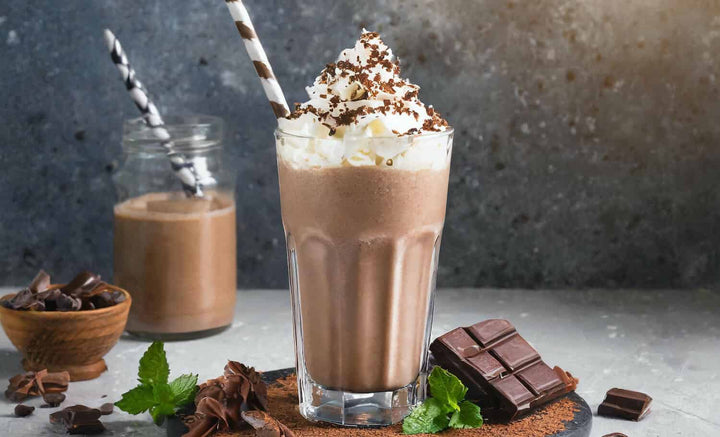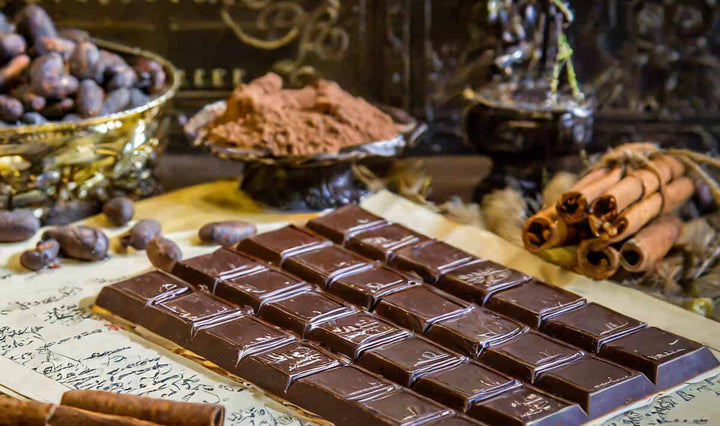Welcome to another in-depth exploration into the wonderful world of chocolate.
As an ardent chocolate lover, you might have noticed percentages, such as 70% or 85%, emblazoned on your favourite dark chocolate bars.
But have you ever wondered what these numbers really mean?
In this post, we will look into the percentages and numbers game in the chocolate industry.
What Does the Percentage Number in Chocolate Mean?
The percentage on a chocolate bar indicates the proportion of the product that comes directly from cocoa beans.
This includes both cocoa solids (such as cocoa powder) and cocoa butter.
For instance, if a dark chocolate bar is labelled as 70%, it means that 70% of the bar is made up of components derived from the cocoa bean, while the remaining 30% consists of other ingredients, such as sugar, milk powder, or additional flavourings.
Related Posts: An Introduction to Cocoa Solids.
What Are Cocoa Solids?
Cocoa solids are the non-fat component of the cocoa bean, which is ground to produce cocoa powder.
This powder is what gives chocolate its distinct flavour.
When cocoa beans are processed, they're first roasted and then separated into cocoa butter (the fatty component) and cocoa solids.
Cocoa solids are responsible for the majority of the nutritional properties of chocolate, including the presence of flavonoids, which are a type of antioxidant.
They also contain theobromine, a mild stimulant.
The percentage of cocoa solids in a chocolate product will significantly influence its taste, with higher percentages resulting in a more bitter, "chocolaty" flavour.
Related Post: All the Different Types of Chocolate.
What Percentage is Dark Chocolate?
Dark chocolate usually contains a higher percentage of cocoa solids than other types of chocolate.
In the UK, dark chocolate must contain at least 35% cocoa solids to qualify as 'dark', but many premium brands offer dark chocolate bars with cocoa percentages as high as 70%, 85%, or even 99%.
The specific cocoa percentage will greatly influence the flavour of the chocolate.
A higher percentage generally equates to a deeper, more bitter taste due to the increased presence of cocoa solids.
Remember, a higher cocoa content also means less room for other ingredients, such as sugar, which is why darker chocolates are often less sweet than their milk chocolate counterparts.
Related Post: What is Cocoa Mass?
What Percentage is Milk Chocolate?
In the UK, to be classified as milk chocolate, a product must contain at least 20% cocoa solids and 20% milk solids.
This typically includes a mix of powdered, condensed, or liquid milk.
The remainder of the chocolate is often made up of sugar and possibly other additives or flavourings.
As a result, milk chocolate is usually sweeter and creamier than dark chocolate.
However, the actual cocoa percentage in milk chocolate can vary between different brands and products.
Some premium milk chocolates might contain a higher proportion of cocoa solids, resulting in a more intense chocolate flavour.
Always check the packaging if you're curious about the specific cocoa percentage in your milk chocolate.
What Percentage is White Chocolate?
White chocolate is a bit different from dark and milk chocolate as it contains no cocoa solids at all.
Instead, white chocolate is made from cocoa butter.
In the UK, to be classified as white chocolate, a product must contain at least 20% cocoa butter and 14% milk solids, with at least 3.5% of the product being milk fat.
The remaining percentage is typically made up of sugar and possibly other flavourings.
As a result, white chocolate is usually the sweetest and creamiest of all the chocolate types, with a buttery, mild flavour that lacks the bitterness associated with cocoa solids.
However, the specific percentages can vary between different brands and products, so always check the packaging if you're interested in the details.
Where Can You Buy Really Tasty Chocolate?
If you’re on the hunt for delicious and high-quality chocolate, look no further than Whitakers Chocolates.
With a rich heritage stretching back over 130 years, Whitakers is a name synonymous with excellence in chocolate-making in the UK.
What sets Whitakers apart is our secret family recipe, honed to perfection over generations, and our uncompromising commitment to using only the finest and most natural ingredients.
The result is a range of chocolates that not only taste exquisite but are also crafted with great care and attention to detail.
A significant aspect of Whitakers Chocolates is our ethical approach to production.
We fervently promote the use of Fairtrade Cocoa across our range, ensuring that our delicious chocolates also contribute to sustainable development and fair treatment of cocoa farmers.
Adding to our commendable practices, all Whitakers dark chocolate products have secured Vegan certification.
This means that everyone, regardless of dietary preferences or requirements, can savour their quality dark chocolates without compromise.
So, whether you’re a discerning chocolate lover, a keen follower of a vegan lifestyle, or simply someone who appreciates fine food produced ethically, Whitakers Chocolates is a brilliant choice.
Our legacy of quality and commitment to doing the right thing makes us a standout option for anyone looking to enjoy truly excellent dark chocolate.
Here are a couple of our favourite chocolate choices:
- Milk chocolate & orange chocolate mint wafer thins
- Milk chocolate 90g bar infused with natural sea salt and smoky caramel flavour
- Dark chocolates with a creamy fondant centre, flavoured with Irish Cream
- Smooth milk chocolate red foiled hearts
- Milk mint chocolate and honeycomb crisps
- Delicious white chocolate and Champagne chocolate truffles
Related Post: What is Cocoa?
Some Notes From an Expert Chocolatier
As an expert chocolatier with years of experience in the field, I can attest to the importance of understanding the cocoa percentage in your chocolate.
Firstly, it's an instant indication of the chocolate's intensity.
A higher percentage, say, 55% or more, means you can expect a rich, complex, and robust chocolate flavour.
Lower percentages, as you'd find in milk chocolate, will give you a sweeter, creamier experience.
The cocoa percentage also tells you a lot about the chocolate's nutritional content.
Higher percentages of cocoa generally mean more fibre, more minerals, and less sugar per bite, which might matter to health-conscious chocolate lovers.
Finally, appreciating the percentage game in chocolate allows you to explore and appreciate the sheer variety the chocolate world offers.
Just a slight change in cocoa percentage can result in a dramatically different flavour experience.
It encourages us to branch out, try new things, and find our personal 'sweet spot' in terms of cocoa content.
At Whitakers Chocolates, we use these percentages to guide our recipes, creating a diverse range of products that cater to every type of chocolate lover.
From our intensely rich dark chocolates to our creamy and sweet milk and white varieties, we strive to create the perfect chocolate experience every time.
Final Notes On What the Percentage Amount in Chocolate Means
The world of chocolate percentages is an interesting journey through the taste, texture, and intensity of this much-loved treat.
Understanding these numbers is about more than just knowing what's in your chocolate.
It's about appreciating the craftsmanship that goes into each bar and discovering the specific cocoa content that suits your palate the best.
The cocoa percentage speaks to the quality and taste of the chocolate, guiding us in our quest for the perfect chocolate experience.
From the rich and robust dark chocolates with high cocoa percentages to the sweet, creamy delights of lower percentage milk and white chocolates, these figures reveal a lot about what to expect from each bite.
Remember that while high cocoa content often signifies quality, it's the balance of ingredients that truly makes for delicious chocolate.
After all, chocolate should be a source of joy and pleasure, and knowing these details simply allows us to appreciate it even more.
So, next time you reach for your favourite bar, take a moment to check the percentage - your perfect chocolate match might just be a number away.











